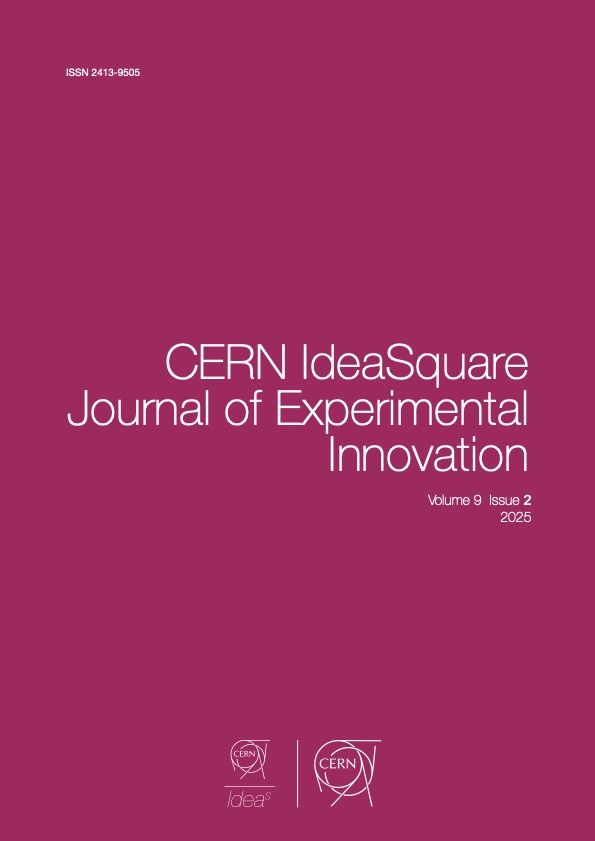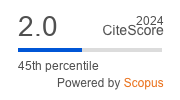Personalised Creativity Development through Design Thinking
DOI:
https://doi.org/10.23726/cij.2025.1711Keywords:
Creativity, personalised learning, design thinkingAbstract
Developing creativity in higher education can be challenging because of the differences in students’ personality- and cognitive traits, creative competence and learning preferences. This pilot study presents a novel prototype of a pedagogical model that integrates principles of design thinking and personalised learning to cultivate creative confidence within a pedagogical setting in higher education. The model is based on a multi-level theoretical framework comprising pedagogy of creativity from micro- and macro level consisting of literature on creativity, creative confidence, how creativity can be practiced, creative diversity, personalised learning as well as design thinking and its educational applications. A quasi-experiment of the pedagogical intervention explores how the students experienced and perceived the outcomes of each step of the design thinking process when applied to their personal creative development. It also investigates what ways the empirical data collected from the intervention align with the core constructs of the proposed model for personalised creativity development. The data is analysed through directed content analysis. The results suggest that design thinking offers a structured approach for supporting cognitive processes of creativity as well as interaction with the surrounding system to increase creative confidence. The main contribution of the experiment is the new hypotheses for further research around the topical issues of design thinking’s pedagogical applications and personalised creativity development.
References
Álvarez-Huerta, P., Muela, A., & Larrea, I. (2022). Disposition toward critical thinking and creative confidence beliefs in higher education students: The mediating role of openness to diversity and challenge. Thinking Skills and Creativity, 43, 101003.
Amabile, T. M. (2017). In pursuit of everyday creativity. The Journal of Creative Behavior, 51(4), 335-337.
Anderson, R. C., & Haney, M. (2021). Reflection in the creative process of early adolescents: The mediating roles of creative metacognition, self-efficacy, and self-concept. Psychology of Aesthetics, Creativity, and the Arts, 15(4), 612. https://doi.org/10.1037/aca0000411
Beghetto, R. A., & Karwowski, M. (2017). Toward untangling creative self-beliefs. In The creative self (pp. 3-22). Academic Press. https://doi.org/10.1016/B978-0-12-809790-8.00001-7
Becket, N., & Brookes, M. (2012). The potential benefits and challenges of personalising UK higher education. Journal of Hospitality, Leisure, Sport & Tourism Education, 11(1), 21-28.
Berlow, E., Canon, S., DeBiswas, K., Gurman, D., Jacoby, S., Simmons, L., ... & Runco, M. (2021). Creative diversity: Patterns in the creative habits of 10,000 people. arXiv preprint arXiv:2108.12759. Retrieved April 4, 2025, from https://arxiv.org/abs/2108.12759
Boronat, B. C., & Choueiry, H. (2022). Transforming creativity skills into creative habits. Arab Economic and Business Journal, 14(1), 80-93.
Brown, T. (2008). Design thinking. Harvard Business Review, 86(6), 84-92.
Burnett, B., & Evans, D. (2016). Designing your life: How to build a well-lived, joyful life. Random House
Csikszentmihalyi, M. (2014). The systems model of creativity and its applications. The Wiley handbook of genius, 533-545. https://doi.org/10.1002/9781118367377.ch25
Csikszentmihalyi, M., Abuhamdeh, S., & Nakamura, J. (2014). Flow. In Flow and the foundations of positive psychology: The collected works of Mihaly Csikszentmihalyi (pp. 227-238). Dordrecht: Springer Netherlands. https://doi.org/10.1007/978-94-017-9088-8
Daikoku, T., Fang, Q., Hamada, T., Handa, Y., & Nagai, Y. (2021). Importance of environmental settings for the temporal dynamics of creativity. Thinking Skills and Creativity, 41, 100911. https://doi.org/10.1016/j.tsc.2021.100911
Dam, R. F. (2023, October 16). The 5 stages in the design thinking process. Interaction Design Foundation - IxDF. Retrieved April 4, 2025, from https://www.interaction-design.org/literature/article/5-stages-in-the-design-thinking-process
De Alencar, E. M. S., de Souza Fleith, D., & Pereira, N. (2017). Creativity in higher education: Challenges and facilitating factors. Temas em Psicologia, 25(2), 553-561.
Dietrich, A. (2015). How creativity happens in the brain. Springer.
Elisondo, R. (2016). Creativity is always a social process. Creativity: Theories–Research–Applications, 3(2), 194-210.
Gopalan, M., Rosinger, K., & Ahn, J. B. (2020). Use of quasi-experimental research designs in education research: Growth, promise, and challenges. Review of Research in Education, 44(1), 218-243. https://doi.org/10.3102/0091732X20903302
Guilford, J. P. (1956). The structure of intellect. Psychological bulletin, 53(4), 267. https://doi.org/10.1037/h0040755
Haapasalo, H., & Kess, P. (2001). In search of organisational creativity: The role of knowledge management. Creativity and innovation management, 10(2), 110-118.
Hasso Plattner Institute of Design at Stanford. (n.d.). An introduction to design thinking: Process guide. Retrieved April 4, 2025, from https://web.stanford.edu/~mshanks/MichaelShanks/files/509554.pdf
Hsieh, H. F., & Shannon, S. E. (2005). Three approaches to qualitative content analysis. Qualitative Health Research, 15(9), 1277-1288. https://doi.org/10.1177/1049732305276687
Hokanson, B., & McCluske, M. (2016). The creativity habit. In Studio teaching in higher education (pp. 192-206). Routledge.
Hope, G. (2015). 20 habits to increase creativity & productivity you can use NOW. Lifehack. Retrieved April 4, 2025, from https://composeronfire.com/wp-content/uploads/2015/01/20-Habits-To-Increase-Creativity-Productivity-You-Can-Use-NOW.pdf
Iandoli, L. (2023). Annual review article: The dual mindset of design-driven entrepreneurship: The case for a pedagogy of making and artefact-centred entrepreneurship education. International Small Business Journal, 41(4), 349-370. https://doi.org/10.1177/02662426231170135
Ibáñez de Aldecoa, P., de Wit, S., & Tebbich, S. (2021). Can habits impede creativity by inducing fixation? Frontiers in Psychology, 12, 683024. https://doi.org/10.3389/fpsyg.2021.683024
Ingold, T. (2013). Making: Anthropology, archaeology, art and architecture. Routledge. https://doi.org/10.4324/9780203559055
Johansson‐Sköldberg, U., Woodilla, J., & Çetinkaya, M. (2013). Design thinking: Past, present and possible futures. Creativity and innovation management, 22(2), 121-146. https://doi.org/10.1111/caim.12023
JongHo, S. H. I. N., & Kim, Y. S. (2010). Design creativity education: Cognitive elements of creativity and an affective model for personalized learning. In The 18th International Conference on Computers in Education (pp. 268-273). Asia-Pacific Society for Computers in Education.
Kampylis, P. G., & Valtanen, J. (2010). Redefining creativity—analyzing definitions, collocations, and consequences. The Journal of Creative Behavior, 44(3), 191-214.
Kelley, T., & Kelley, D. (2013). Creative confidence: Unleashing the creative potential within us all. Crown Currency.
Kim, B., & Tan, L. (2022). Design thinking the future: Critical perspectives on design studies, design knowledge, and education. In Design praxiology and phenomenology: Understanding ways of knowing through inventive practices (pp. 3-15). Springer. https://doi.org/10.1007/978-981-16-3844-1_1
Liedtka, J., King, A., & Bennett, K. (2013). Solving problems with design thinking: Ten stories of what works. Columbia University Press.
Lin, C. F., Yeh, Y. C., Hung, Y. H., & Chang, R. I. (2013). Data mining for providing a personalized learning path in creativity: An application of decision trees. Computers & Education, 68, 199-210.
Panke, S. (2019). Design thinking in education: Perspectives, opportunities, and challenges. Open Education Studies, 1(1), 281-306.
Poláková, M., Suleimanová, J. H., Madzík, P., Copuš, L., Molnárová, I., & Polednová, J. (2023). Soft skills and their importance in the labour market under the conditions of Industry 5.0. Heliyon, 9(8), e17387.
Prain, V., Cox, P., Deed, C., Dorman, J., Edwards, D., Farrelly, C., ... & Yager, Z. (2013). Personalised learning: Lessons to be learnt. British Educational Research Journal, 39(4), 654-676.
Pressman, A. (2018). Design thinking: A guide to creative problem solving for everyone. Routledge.
Redding, S. (2016). Competencies and personalized learning. In M. Murphy, S. Redding, & J. Twyman (Eds.), Handbook on personalized learning for states, districts, and schools (pp. 3-18). Springer.
Rösch, N., Tiberius, V., & Kraus, S. (2023). Design thinking for innovation: Context factors, process, and outcomes. European Journal of Innovation Management, 26(7), 160-176.
Salvi, C., & Bowden, E. M. (2016). Looking for creativity: Where do we look when we look for new ideas? Frontiers in Psychology, 7, 161. https://doi.org/10.3389/fpsyg.2016.00161
Scheffer, M., Baas, M., & Bjordam, T. K. (2017). Teaching originality? Common habits behind creative production in science and arts. Ecology and Society, 22(2).
Schumpeter, J. A. (1983). The theory of economic development: An inquiry into profits, capital, credit, interest, and the business cycle (Reprint of the 1934 edition). Transaction.
Scott, G., Leritz, L. E., & Mumford, M. D. (2004). Types of creativity training: Approaches and their effectiveness. The Journal of Creative Behavior, 38(3), 149-179. https://doi.org/10.1002/j.2162-6057.2004.tb01238.x
Shemshack, A., Kinshuk, & Spector, J. M. (2021). A comprehensive analysis of personalized learning components. Journal of Computers in Education, 8(4), 485-503.
Slepian, M. L., & Ambady, N. (2012). Fluid movement and creativity. Journal of Experimental Psychology: General, 141(4), 625.
Sternberg, R. (2007). Creativity as a habit. In Creativity: A handbook for teachers (pp. 3-25). University Press of America.
Taimur, S., Peukert, D., & Pearce, B. (2023). Design thinking. In P. Orsten Philipp & T. Schmohl (Eds.), Handbook transdisciplinary learning (pp. 83-93). Springer.
Todt, G., Wolf, B., & Maisch, B. (2024). Navigating peaks and valleys—Fostering resilience via entrepreneurial life design. CERN IdeaSquare Journal of Experimental Innovation, 8(3), 28-35. https://doi.org/10.23726/cijoi.2024.181
Verganti, R., Dell’Era, C., & Swan, K. S. (2021). Design thinking: Critical analysis and future evolution. Journal of Product Innovation Management, 38(6), 603-622. https://doi.org/10.1111/jpim.12610
Wolniak, R. (2017). The design thinking method and its stages. Systemy Wspomagania w Inżynierii Produkcji, 6(6), 247-255.
World Economic Forum. (2025). Future of jobs report. Retrieved April 4, 2025, from https://www.weforum.org/publications/the-future-of-jobs-report-2025/digest/
Yazan, B. (2015). Three approaches to case study methods in education: Yin, Merriam, and Stake. https://doi.org/10.46743/2160-3715/2015.2102
Zhang, L., Basham, J. D., & Yang, S. (2020). Understanding the implementation of personalized learning: A research synthesis. Educational Research Review, 31, 100339. https://doi.org/10.1016/j.edurev.2020.100339
Zwir, I., Del-Val, C., Hintsanen, M., Cloninger, K. M., Romero-Zaliz, R., Mesa, A., ... & Cloninger, C. R. (2022). Evolution of genetic networks for human creativity. Molecular Psychiatry, 27(1), 354-376.
Downloads
Published
How to Cite
License
Copyright (c) 2025 Nina Jackson, Kari-Pekka Heikkinen, Harri Haapasalo

This work is licensed under a Creative Commons Attribution 4.0 International License.
Authors who publish with this journal agree to the following terms:
- Authors retain copyright and grant the journal right of first publication with the work simultaneously licensed under a Creative Commons Attribution License that allows others to share the work with an acknowledgement of the work's authorship and initial publication in this journal.
- Authors are able to enter into separate, additional contractual arrangements for the non-exclusive distribution of the journal's published version of the work (e.g., post it to an institutional repository or publish it in a book), with an acknowledgement of its initial publication in this journal.
- Authors are permitted and encouraged to post their work online (e.g., in institutional repositories or on their website) prior to and during the submission process, as it can lead to productive exchanges, as well as earlier and greater citation of published work (See The Effect of Open Access).


